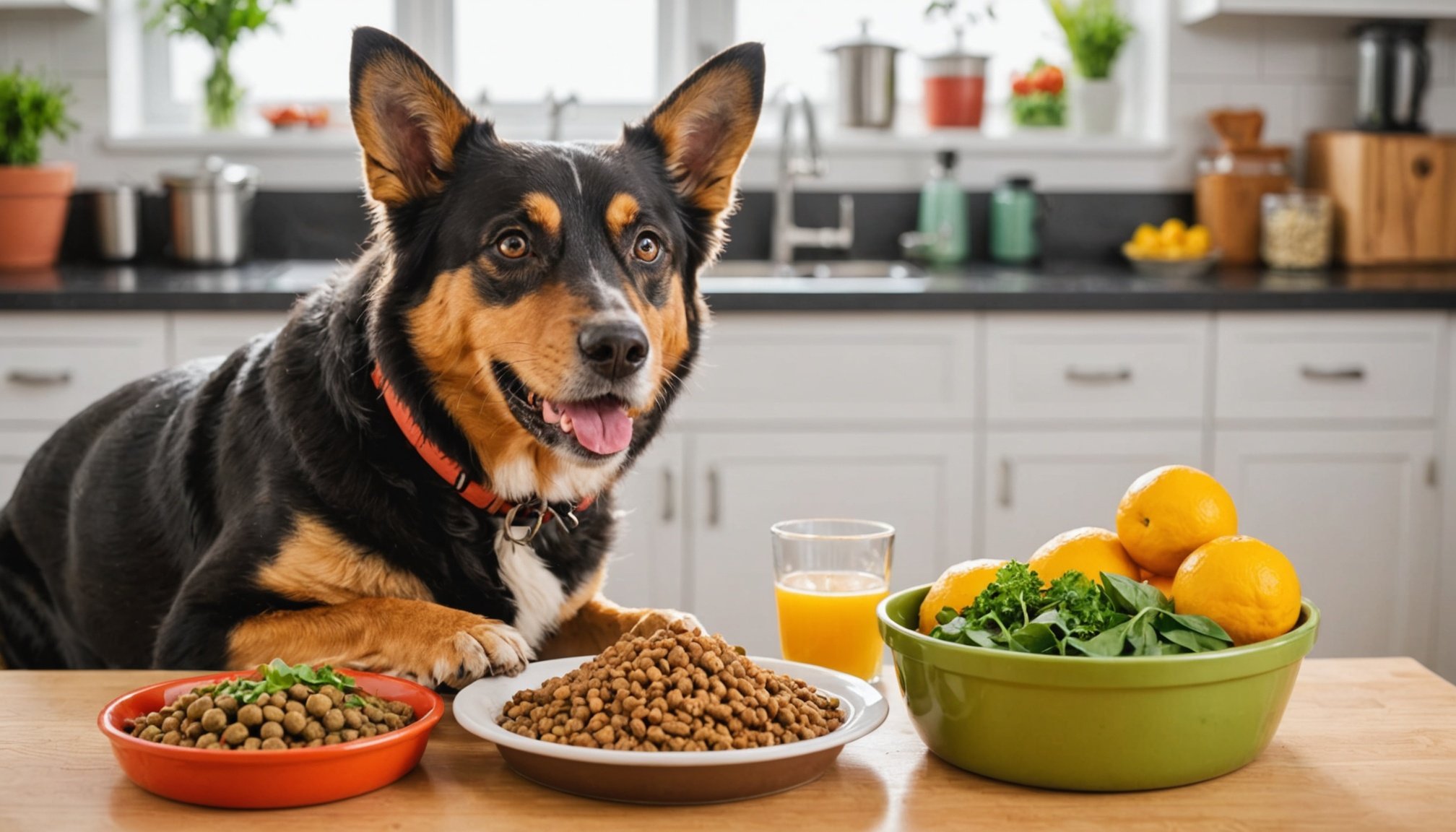Top Tips for Whipping Up Allergy-Friendly Homemade Dog Food: A Guide for Caring Pet Owners
As a caring pet owner, there’s nothing more rewarding than seeing your furry friend thrive on a diet that not only tastes great but also meets their specific health needs. For dogs suffering from food allergies, homemade dog food can be a game-changer. Here’s a comprehensive guide to help you create allergy-friendly homemade dog food that your pup will love.
Understanding Food Allergies in Dogs
Before diving into the recipes, it’s crucial to understand what food allergies in dogs entail. Food allergies are immune reactions to specific ingredients, often proteins, in your dog’s diet. The most common allergens include beef, chicken, eggs, fish, and dairy products, as well as some grains[3].
Also to discover : Top Training Treats That Will Motivate Even the Stubbornest Pugs!
Identifying Allergens
To create an effective allergy-friendly diet, you need to identify what your dog is allergic to. This often involves an elimination diet or consulting with your veterinarian for allergy testing. Here are some common signs of food allergies to look out for:
- Itchy skin
- Vomiting
- Diarrhea
- Repeat ear infections
If you suspect your dog has a food allergy, it’s essential to consult with a veterinarian to determine the best course of action.
In parallel : Key Attributes of a Premium Cat Travel Carrier: Essential Features You Can”t Overlook!
The Importance of Veterinary Guidance
While the idea of making your dog’s food at home might seem straightforward, it’s anything but simple. Homemade dog food requires careful planning to ensure it is nutritionally balanced.
Why You Need a Veterinary Nutritionist
All homemade diets should be formulated by board-certified veterinary nutritionists. This is because a one-off healthy homecooked meal won’t hurt your dog, but feeding the wrong formula for too long can lead to severe nutritional deficiencies, especially in puppies[2].
A study in the Journal of the American Veterinary Medical Association highlighted that recipes written by non-veterinarians tended to have a greater number and severity of nutrient deficiencies. Therefore, it’s vital to adhere strictly to the instructions provided by a board-certified veterinary nutritionist.
Choosing the Right Ingredients
When it comes to creating allergy-friendly homemade dog food, the choice of ingredients is paramount.
Protein Sources
For dogs with protein allergies, you need to select alternative protein sources that are less likely to trigger an allergic reaction. Here are some options:
- Venison: A novel protein source that is often used in allergy-friendly recipes.
- Duck: Another novel protein that can be a good alternative to common allergens like chicken and beef.
- Bison: Rich in protein and lower in fat, bison can be an excellent choice.
- Turkey: While some dogs may be allergic to turkey, it can be a good option for those who are not.
Vegetables and Fruits
In addition to protein sources, vegetables and fruits can add essential nutrients to your dog’s diet. Here are some healthy options:
- Sweet Potatoes: Rich in fiber, vitamins, and minerals, sweet potatoes are a great addition to homemade dog food.
- Carrots: High in vitamin A and fiber, carrots are a healthy snack for dogs.
- Green Beans: Low in calories and rich in fiber, green beans are a great treat.
- Apples: Without seeds and cores, apples can be a tasty and healthy treat for dogs[3].
Sample Recipe for Allergy-Friendly Homemade Dog Food
Here’s a sample recipe that you can use as a starting point, but always consult with a veterinary nutritionist before making any changes to your dog’s diet.
Ingredients:
- 3 lbs ground venison (or alternative protein like duck, bison, or turkey)
- 1 pound sweet potatoes, diced
- 1 pound carrots, diced
- 1 cup green beans, chopped
- 2 tablespoons coconut oil (ensure it is part of the formulated recipe, as coconut oil lacks essential fatty acids on its own)
- 1 teaspoon flaxseed oil (for omega-3 fatty acids)
Instructions:
- Preheat Oven: Preheat your oven to 350°F (175°C).
- Cook Sweet Potatoes and Carrots: Bake the sweet potatoes and carrots for about 45 minutes, or until they are tender.
- Cook Green Beans: Steam the green beans until they are tender but still crisp.
- Mix Ingredients: Combine the cooked sweet potatoes, carrots, and green beans with the ground venison.
- Add Oils: Mix in the coconut oil and flaxseed oil according to the recipe formulated by your veterinary nutritionist.
Tips for Preparing Homemade Dog Food
Preparing homemade dog food requires attention to detail to ensure it is both healthy and safe for your dog.
Avoid Common Mistakes
Here are some common mistakes to avoid:
- Swapping Ingredients: Do not swap ingredients without consulting your veterinary nutritionist. For example, coconut oil and olive oil lack essential fatty acids that are good for your dog[2].
- Cooking Methods: Boiling rather than baking can add moisture, which reduces the nutrients per gram. Always follow the cooking method recommended by your veterinary nutritionist.
- Bones and Choking Hazards: Ensure all bones are removed from meats to avoid choking hazards and intestinal issues[3].
Palatability and Digestibility
Homemade diets are often more palatable and digestible for dogs. Here are some benefits:
- Improved Stool Quality: Homemade diets can lead to improved stool quality and reduced volume, indicating better nutrient absorption[2].
- Including Favorite Foods: You can consult a board-certified veterinary nutritionist to include some of your dog’s favorite foods as part of the diet plan, making mealtime more enjoyable[2].
Practical Insights and Actionable Advice
Here are some practical tips and advice to help you get started:
Consult Your Veterinarian
Before making any changes to your dog’s diet, consult with your veterinarian. They can help you identify allergens and formulate a diet that meets your dog’s nutritional needs.
Use High-Quality Ingredients
Always use high-quality ingredients to ensure your dog is getting the best nutrition possible.
Keep it Consistent
Stick to the recipe formulated by your veterinary nutritionist. Consistency is key in maintaining your dog’s health.
Table: Comparing Commercial vs. Homemade Dog Food
| Aspect | Commercial Dog Food | Homemade Dog Food |
|---|---|---|
| Nutritional Balance | Often balanced but may contain allergens | Must be formulated by a veterinary nutritionist to ensure balance |
| Customization | Limited customization options | Can be tailored to individual dog’s needs and allergies |
| Palatability | May not be as palatable for some dogs | Generally more palatable and digestible |
| Cost | Can be cost-effective in the long run | May be more expensive due to the need for high-quality ingredients and veterinary guidance |
| Health Benefits | Can help manage health conditions but may contain allergens | Can help manage specific health conditions and allergies effectively |
Quotes from Experts
- “Even cooked bones are risky,” says Dr. Sylvia Berns, Sploot’s Medical Director. “They can splinter in the dog’s GI tract and cause issues such as perforations. It’s a good reminder just in case (pet) parents think bones would be okay if cooked, which is not the case.”[3]
- “Homemade diets can help with other health problems. In kidney disease, for example, the diet is the mainstay of veterinary treatment, and protein and phosphorus usually need to be restricted,” highlights an article from Dogster[2].
Creating allergy-friendly homemade dog food is a thoughtful and caring approach to your pet’s health. By understanding the common allergens, consulting with a veterinary nutritionist, and using the right ingredients, you can ensure your dog enjoys healthy, balanced meals. Remember, consistency and adherence to the formulated recipe are key to maintaining your dog’s health and well-being.
With these tips and insights, you can embark on the journey of making homemade dog food that your furry friend will not only love but also thrive on. Happy cooking











